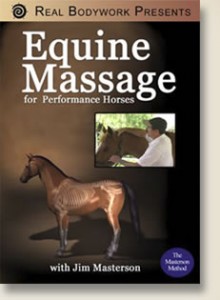Another video rental. This one features the work of Jim Masterson. In this video he demonstrates the Masterson Method for Integrated Equine Performance Bodywork which he developed.
Like a lot of people I’ve watched horses getting massage therapy numerous times. I’ve read some books too. Sure, I’d rub on my horses but I had no illusion of thinking anything I did was actually beneficial from a massage point of view. How was I to know what area should be worked on? Or, for how long? No idea!!
Anyway, what I loved about this video was it did more than make me feel like I could do some massage on my own horses in a manner that might actually be beneficial–which it did. But it also gave me some real insight into reading the most subtle signs the horse will offer about how he or she is feeling. For instance, the very first signs to look for are eyes blinking and twitching around the mouth. As you move your hands over the horse (the video demonstrates where and with how much pressure) these signs are an indicator you’ve found a spot holding tension. When the horse releases the tension, after your gentle massage of the area, the horse will lick, chew and (sometimes even) yawn. After viewing the video I tried out some of the techniques on a few different horses. Each responded as expected per the video. Really cool!! 🙂
The horse I was most interested in hearing from was Tulsa, my introverted 20 year old mare. I was watching an episode of House recently. In this show the patient was unable to speak or move. Yet, he was fully aware trapped within his body. One of the doctors had the idea of hooking the patient up to a machine that would allow him to communicate by learning to control a cursor on a screen with brain signals. He was then able to at least answer yes or no to questions. This proved to be the breakthrough needed to resolve the problem because they could communicate.
This so reminded me of working with my horse, Tulsa. It is, to me, as if she is trapped in her body unable to outwardly communicate. I’ve always had the feeling that Tulsa was hiding in a ‘cement suit’. Does she hurt? What does she protect? Why? Unlike many horses who will act out and let you know clear when something is wrong, Tulsa holds it in. So I was both curious about how she would respond to these techniques as well as hopeful that this approach might be the key to connecting with her and drawing her out.
Once I became attuned to the signals I found that even Tulsa gave the initial subtle signals. SO tiny… SO subtle. What she didn’t do, at least not quickly like the horses in the video or even the other ones I worked on, was offer signs of releasing the tension (licking/chewing/yawning). But, decided to persist in the slow and gentle manner that Jim advocates and began to find areas where she DID offer releases–sometimes huge releases! This made me Very Happy. 🙂 🙂
It is still early to tell how much this will influence her overall way of going. But, I’m hopeful that if I just keep chipping away at the cement suit her inner beauty will shine as much on the outside as the inside. I will be sure to document her progress here.
My horsemanship journey already had me on a path that depends on observing and rewarding small changes. So, this is just a continuation of all that and a good fit with what I already am doing. A way of going even deeper and giving me tools for helping even more horses. I love how these things integrate.
Jim has a website where you can read more about his methods: http://www.mastersonmethod.com/articles
And, here’s a short video of Jim working on a horse. This is just one of six available on YouTube.
And here’s the link to the video:


Sound interesting. I’ll have to check it out.
Massage for horses can be so wonderful. I worked on a guest ranch in CO several summers ago. Our horse were ridden anywhere from 3-6 hours a day and some of them would get quite tense. There was an equine massage school nearby and they would come every few weeks and work on our horses for free. The horses absolutely loved it!
I’ve always been skeptical about doing my own massage because I’ve been afraid of doing more harm than good. So do you think the video gives enough advice for the novice massager to be successful?
cheers,
Mary H.
http://stalecheerios.com/blog
That’s super! Keep those video reviews coming!
I’ve been doing a little remedial massage on Gabe lately. He’s out of action while his feet adjust to being shoeless. It seems to really help calm him and has done great things for our relationship. My Mare, Shamar, won’t sit still for massage. I may as well be goosing her. For her, I purchased an endostick from JP Giacomini. I haven’t yet watched the DVD, so all I’ve done is tap for relaxation. It’s worked really well. She sat still, chewed and yawned inside of five minutes.
Thanks for the comments, folks! Kinni for your mare, you might want to look into Jim Masterson’s method. It is SO gentle! No chance of ‘goosing’. 🙂 It is a wonderful compliment to all we do as horse(wo)men.
wonderful intro to this guy. thank you! i too have been afraid to begin learning massage. did you say “video rental?” where do you rent this video?
Hi Liz,
Yes, you can rent his video. I rented it from the now defunct Horseflix.com but I notice that it is available from Giddyupflix.com. Well worth it! Love the video rental concept!–Sharon